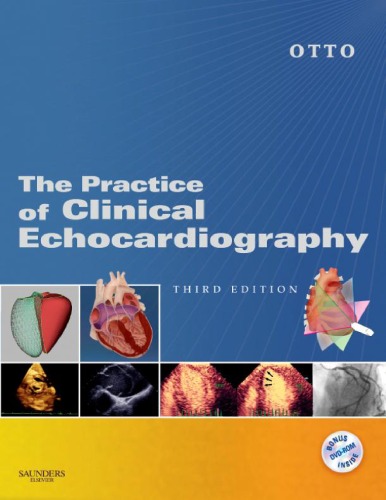

Most ebook files are in PDF format, so you can easily read them using various software such as Foxit Reader or directly on the Google Chrome browser.
Some ebook files are released by publishers in other formats such as .awz, .mobi, .epub, .fb2, etc. You may need to install specific software to read these formats on mobile/PC, such as Calibre.
Please read the tutorial at this link: https://ebookbell.com/faq
We offer FREE conversion to the popular formats you request; however, this may take some time. Therefore, right after payment, please email us, and we will try to provide the service as quickly as possible.
For some exceptional file formats or broken links (if any), please refrain from opening any disputes. Instead, email us first, and we will try to assist within a maximum of 6 hours.
EbookBell Team

0.0
0 reviews 
ISBN 10: 1416036407
ISBN 13: 978-1416036401
Author: Catherine M. Otto
Dr. Otto's best-selling text not only explains how to qualitatively and quantitatively interpret echocardiographic images and Doppler flow data, but also outlines how this information affects your clinical decision making. This edition features new chapters on tissue doppler, intracardiac echocardiography, hand-held echocardiography, and echocardiography in inherited connective tissue disorders. A companion DVD offers case-based multiple-choice questions to help you assess your understanding. Whether you are attempting to choose a course of therapy, ascertain the optimal timing for intervention, arrive at a prognosis, or determine the possible need for periodic diagnostic evaluation, this is an essential resource you'll consult time and time again.
Part One: Advanced Echocardiographic Techniques
Chapter 1: Transesophageal Echocardiography
Chapter 2: Monitoring Ventricular Function in the Operating Room: Impact on Clinical Outcome
Chapter 3: Contrast Ultrasound Imaging: Methods, Analysis, and Applications
Chapter 4: Three-Dimensional Echocardiography
Chapter 5: Tissue Doppler and Speckle Tracking Echocardiography
Chapter 6: Intracardiac Echocardiography
Chapter 7: Intravascular Ultrasound: Principles and Clinical Applications
Chapter 8: Hand-Carried Ultrasound
Part Two: The Left Ventricle
Chapter 9: Quantitative Evaluation of Left Ventricular Structure, Wall Stress, and Systolic Function
Chapter 10: Ventricular Shape and Function
Chapter 11: Assessment of Diastolic Function by Echocardiography
Chapter 12: Echocardiographic Digital Image Processing and Approaches to Automated Border Detection
Part Three: Ischemic Heart Disease
Chapter 13: The Role of Echocardiographic Evaluation in Patients Presenting with Acute Chest Pain in the Emergency Room
Chapter 14: Echocardiography in the Coronary Care Unit: Management of Acute Myocardial Infarction, Detection of Complications, and Prognostic Implications
Chapter 15: Exercise Echocardiography
Chapter 16: Stress Echocardiography with Nonexercise Techniques: Principles, Protocols, Interpretation, and Clinical Applications
Chapter 17: Echocardiographic Evaluation of Coronary Blood Flow: Approaches and Clinical Applications
Part Four: Valvular Heart Disease
Chapter 18: Quantification of Valvular Regurgitation
Chapter 19: Timing of Intervention for Chronic Valve Regurgitation: The Role of Echocardiography
Chapter 20: Intraoperative Echocardiography in Mitral Valve Repair
Chapter 21: Echocardiography in the Patient Undergoing Catheter Balloon Mitral Valvuloplasty: Patient Selection, Hemodynamic Results, Complications, and Long-Term Outcome
Chapter 22: Clinical Decision Making in Patients with Endocarditis: The Role of Echocardiography
Chapter 23: Aortic Stenosis: Echocardiographic Evaluation of Disease Severity, Disease Progression, and the Role of Echocardiography in Clinical Decision Making
Chapter 24: Fluid Dynamics of Prosthetic Valves
Chapter 25: Echocardiographic Recognition and Quantitation of Prosthetic Valve Dysfunction
Chapter 26: Echocardiographic Recognition of Unusual Complications after Surgery on the Great Vessels and Cardiac Valves
Part Five: Cardiomyopathies and Pericardial Disease
Chapter 27: Doppler Echocardiography in Heart Failure and Cardiac Resynchronization
Chapter 28: Echocardiography in the Evaluation and Management of Patients with Hypertrophic Cardiomyopathy
Chapter 29: Restrictive Cardiomyopathy: Diagnosis and Prognostic Implications
Chapter 30: Pericardial Disease
Chapter 31: End-Stage Heart Failure: Ventricular Assist Devices and the Posttransplant Patient
Part Six: The Pregnant Patient
Chapter 32: Role of Echocardiography in the Diagnosis and Management of Heart Disease in Pregnancy
Part Seven: Vascular and Systemic Diseases
Chapter 33: Aortic Dissection and Trauma: Value and Limitations of Echocardiography
Chapter 34: Hypertension: Impact of Echocardiographic Data on the Mechanism of Hypertension, Treatment, Options, Prognosis, and Assessment of Therapy
Chapter 35: Echocardiographic Findings in Acute and Chronic Respiratory Disease
Chapter 36: Echocardiographic Findings in Systemic Diseases Characterized by Immune-Mediated Injury
Chapter 37: Echocardiography in the Evaluation of Cardiac Disease Resulting from Endocrinopathies, Renal Disease, Obesity, and Nutritional Deficiencies
Chapter 38: Echocardiography in Patients with Inherited Connective Tissue Disorders
Chapter 39: Aging Changes Seen on Echocardiography
Chapter 40: Echocardiographic Evaluation of the Patient with a Systemic Embolic Event
Chapter 41: The Role of Echocardiography in Atrial Fibrillation and Flutter
Part Eight: Adult Congenital Heart Disease and Cardiac Tumors
Chapter 42: General Echocardiographic Approach to the Adult with Suspected Congenital Heart Disease
Chapter 43: Echocardiographic Evaluation of the Adult with Unoperated Congenital Heart Disease
Chapter 44: Echocardiographic Evaluation of the Adult with Postoperative Congenital Heart Disease
Chapter 45: Cardiac Tumors
the practice of clinical echocardiography
practice of clinical echocardiography 6th edition
what is e' in echocardiography
what is echocardiography
types of stress echocardiogram
echo practice